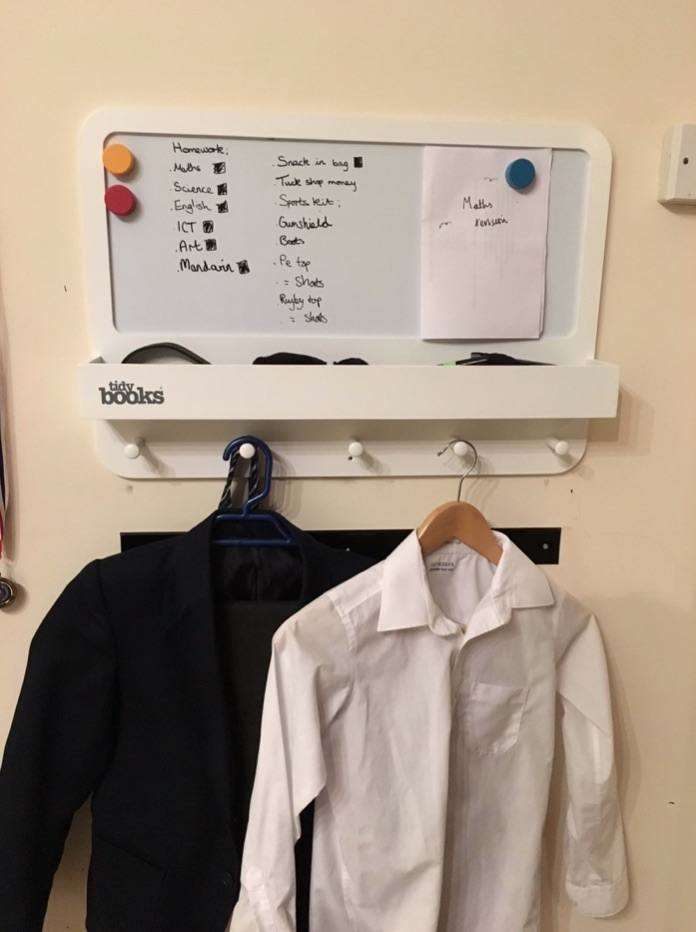The summer is over and children are returning to school. Some children (and parents) cant wait for the schools to re-open. But others feel anxious and worry about the term ahead. Louis’ story; and how his mum’s super-organising tactics have helped him manage his dyspraxia, can help everyone make it the return to school a little less stressful for both parents and children.
Even on a school day, let alone the first day back to school afetr 8 weeks off, Louis, 13, finds it difficult to pick out the right uniform in the morning, choose what breakfast to have and remember everything he needs to put in his bag. He has dyspraxia, which is sometimes called ‘clumsy child syndrome’. Dyspraxia affects Louis’ ability to organise his thoughts, short term memory and physical co-ordination. It slows Louis down just when he needs to be faster in the mornings.
Louis was diagnosed with dyspraxia around the time he started secondary school. Dyspraxia affects 10% of children, with boys more likely to have the condition. 2% of children have severe dyspraxia.
Getting a diagnosis marked a turning point, from which Louis has shown a steely determination in overcoming his condition. Even though he has has never managed to go upstairs without falling up them, Louis is now a county-level champion hurdler.
He’s in great company. Other famous people with creative genius who have dyspraxia include Albert Einstein, Harry Potter’s Daniel Radcliffe who’s said he has trouble tying his shoe laces and Richard Branson – who’s not well known for giving up easily.
“You don’t learn to walk by following rules. You learn by doing and falling over”
Louis’ mum Jen, had to step up her organisation skills to military level, just to get Louis out of the door on time. I chatted to Jen of The Dad Network blog to discover what she does to help Louis get organised and prepared for school every morning. She had 9 key tips.
1.Put homework, exam timetables and uniform in a place they can’t miss.
SATs, starting secondary school and exams mean kids have to organise themselves. Louis has a notice board in his bedroom, right by the door, that he uses every night to write up what exactly to be done to be ready for school the next day.
Jen hangs up Louis’ clothes on the board’s pegs in the order he needs them, so he does not have to make any choices, or look for anything he needs in the morning.
buy ventolin online https://www.parkviewortho.com/wp-content/languages/new/prescription/ventolin.html no prescription
This noticeboard, which Jen called a ‘lifechanger’ gives Louis a visual prompt and a ‘map’ for getting dressed. As he doesn’t have to make any decisions in the morning, he can concentrate on getting out of the door on time.

(Tidy Books currently have up to 50% off this notice board too!)
2. Decide what you want for breakfast the night before
Louis chooses what he wants for breakfast before he goes to bed. Many people with dyspraxia find it difficult to plan, and concentrate., even to make the choice of what to eat, and often struggle to open jars/bottles without spilling things. Jen lays out the table each night, ready for the morning. This makes breakfast time much quicker.
3. Label everything in one colour
It’s not uncommon to lose your PE kit now and again, but Louis was losing his trainers and kit nearly every lesson or race meeting. Jen now uses big name labels in Louis’ favourite colour; neon green, which means he can find his clothes from the changing room floor without hunting through name tags. Labels like these ones can be added to water bottles or calculators to keep everything together.
4. Pick a favourite colour and stick to it.
Colour coding is a great way to organise. Dyspraxic children are very tuned in to visual prompts, so Jen buys school pens, pencils and cases all in one colour, so Louis can see his belongings instantly. Using a see-through pencil case allows Louis to find what he wants quickly without taking up too much time. Everything Louis takes to school is labelled in the same style font and in the same neon green. It means he can skim the room for his belongings, picking them out quickly by colour.
5. Use a rubber pen or pencil grip
Dyspraxia affects fine motor coordination, and Jen found that Louis’ had given himself ridges on his fingers from holding his pen too tightly. A rubber grip can make writing more comfortable, particularly as kids have to write for long periods of time.
6. Note Keeping
Many children with dyspraxia struggle to retain key information and even the simplest of instructions can be forgotton quickly. Louis has learnt to write things down so that he can refer to them later on.
buy orlistat online https://www.parkviewortho.com/wp-content/languages/new/prescription/orlistat.html
no prescription
7.Timers
The concept of time can be a tricky one for many children. Louis has multiple stop clocks which are set to the desired time for each activity. when he goes to clean his teeth he sets the timer to three minutes and then a buzzer will sound. When we say, ” we are leaving the house in five minutes,” the timer is set and then he has a visual record to know exactly when he needs to be ready.
8. Movement
Some children with dyspraxia will say that their bodies feel uncomfortable in certain positions or sitting still for long periods of time. Louis often leans on things or positions himself in unusual ways. His teachers have been extremly understanding and he is allowed to stand in lessons when he needs to as well as being given breaks from lessons and exams to move his body. He also regularly visits a physio.
9. Embrace your child’s uniqueness and find hacks that suit their individual needs to make their life easier.
No two children are the same. And from our experience, no two cases of dyspraxia are the same either. Each child will have differing needs and some tips and tricks that work for one may not work for another. Talking to your child about what they struggle with and involving them in the process of trying to find ways to support them can be the key to success.
Louis still loses things; trainers, money, phones, but Jen’s organising tactics are giving him the tools to become more independent, and less frustrated. And while extreme organisation looks like hard work, it means that he can concentrate less on what he’s lost and more on winning races and his school work.
If your family finds it a challenge to get organised in the morning, these tips could mean you all get out of the door on time.
For more information on living with dyspraxia visit the Dyspraxia Foundation website
Thanks to Jen of The Dad Network and Louis for sharing their story!
*Louis was diagnosed with Dyspraxia two years ago. Since then he has had Educational Psychology reports as well as Occupational Therapy reports. Jen is a teacher and has also worked as a SENCO. If you have any questions at all, or would like to share your experiences with someone that understands then please do not hesitate to get in touch.
Written by Ruth Duncan







